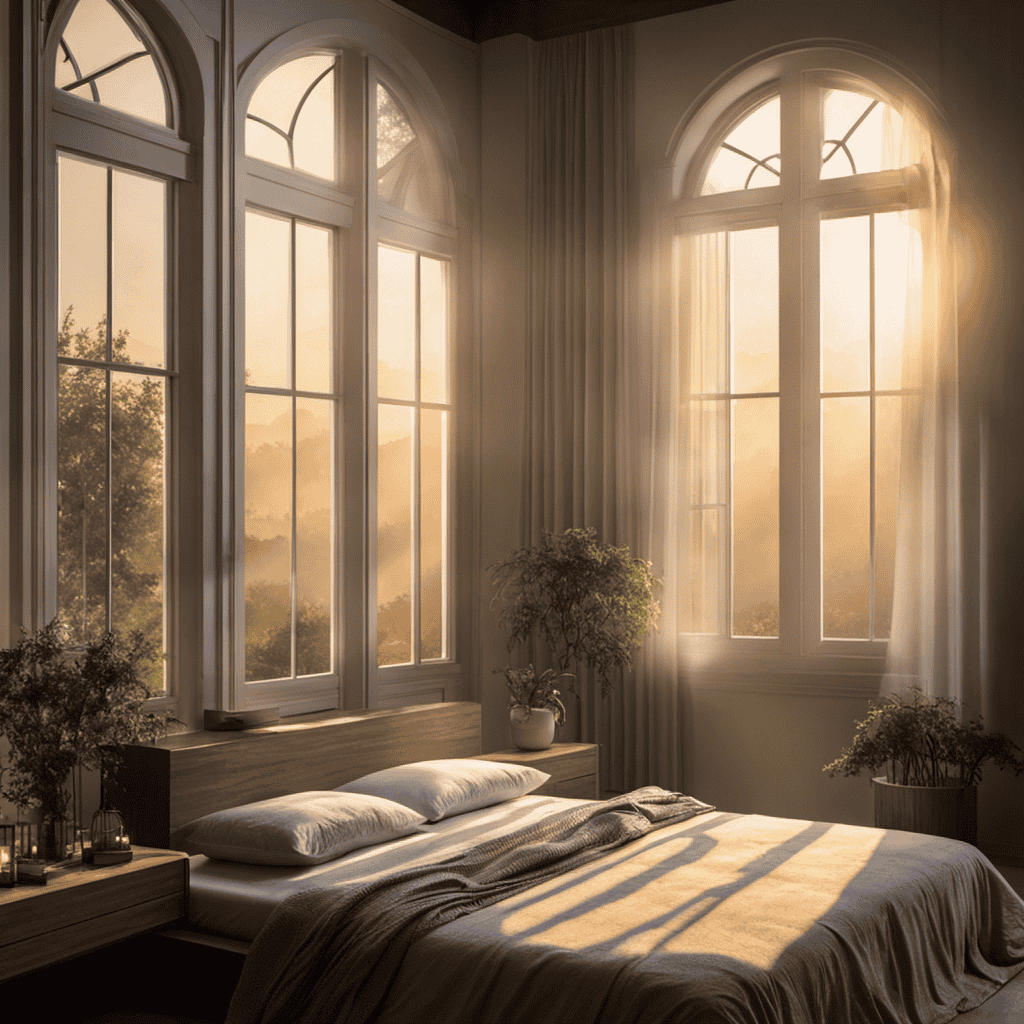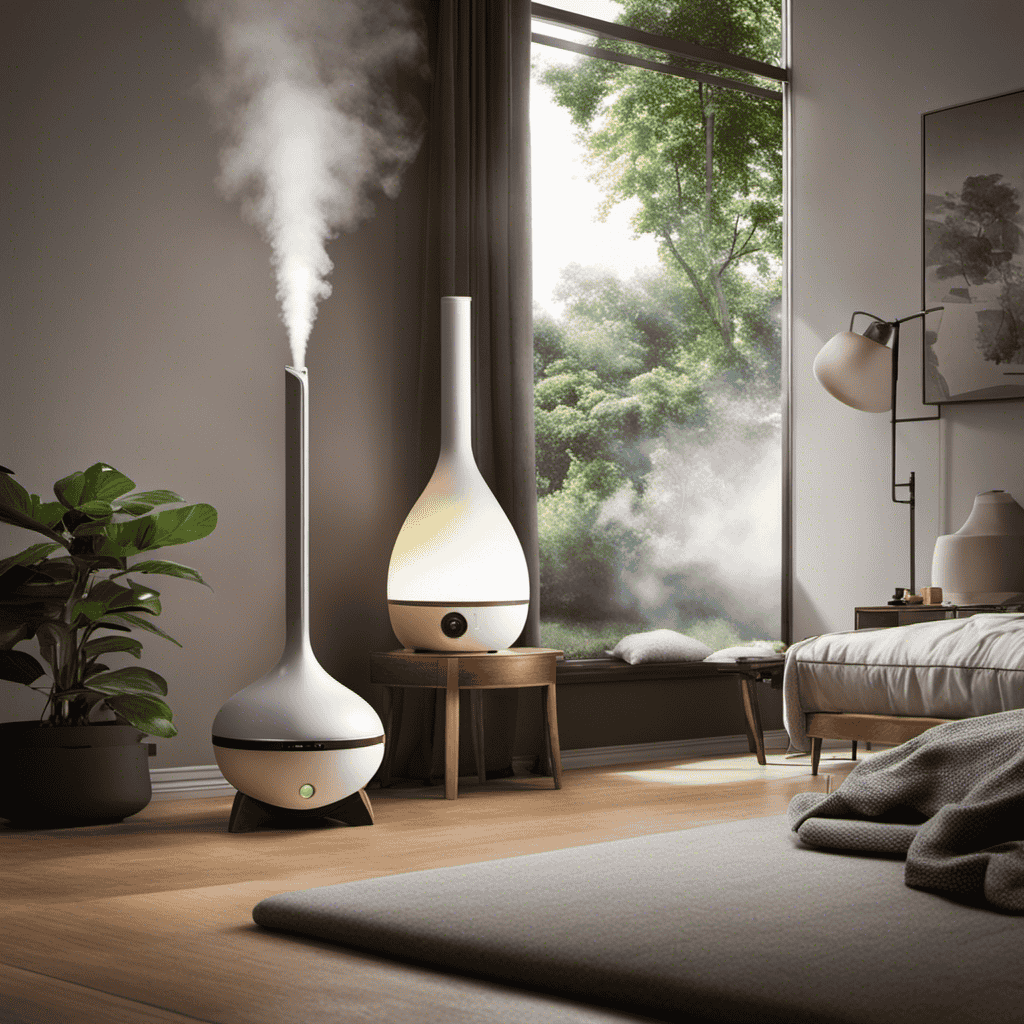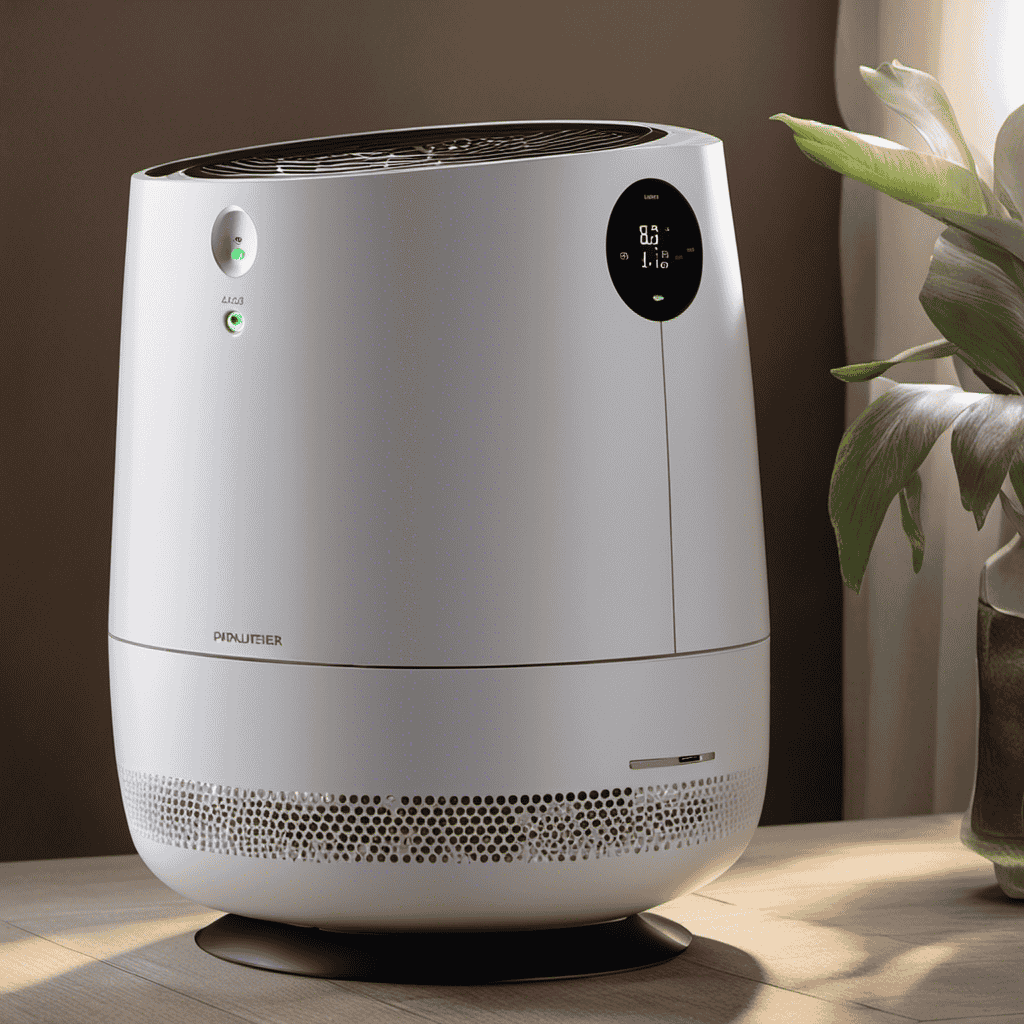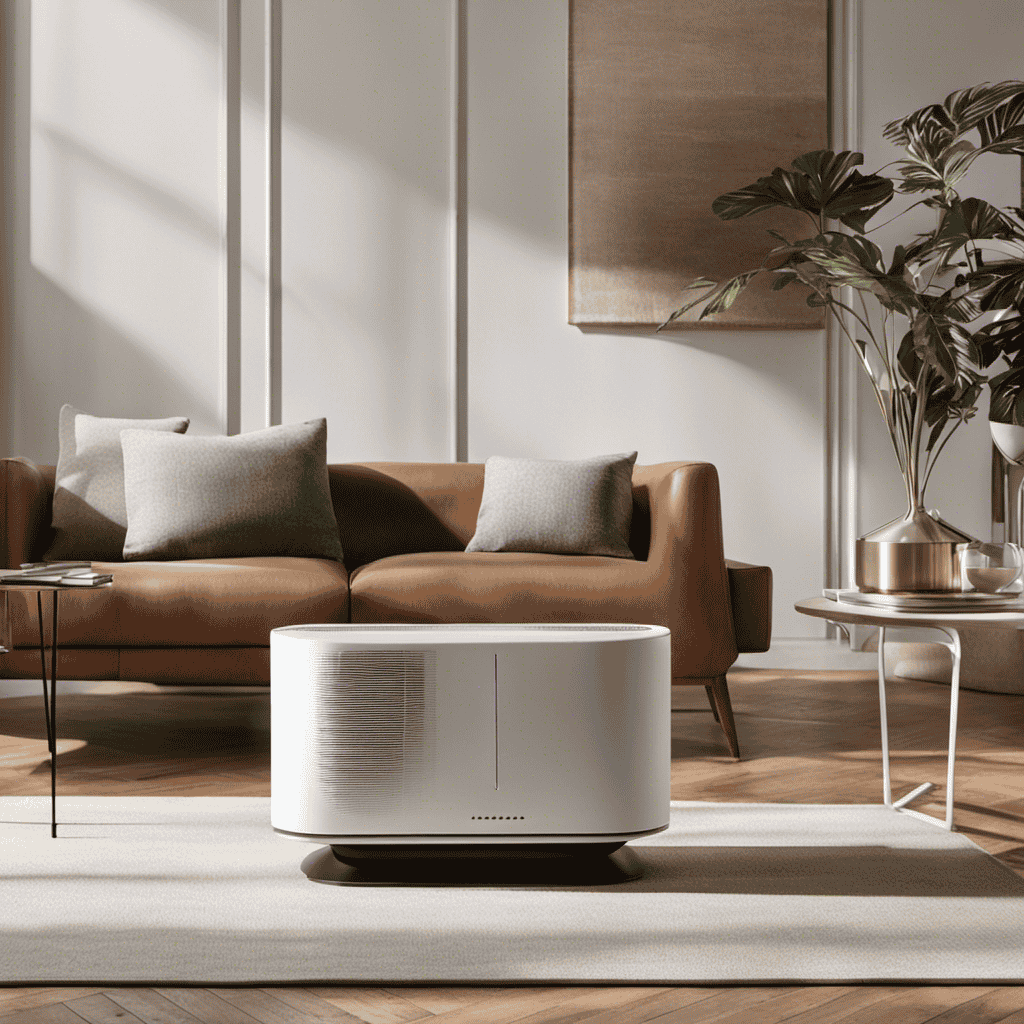I get why you might be unsure about **whether an air purifier is necessary**. Some may think the air around us is already fresh and pure. But, truth is, the air inside our homes can contain harmful substances that can harm our well-being. If you want to ensure **cleaner indoor air** and a healthier home, keep exploring to learn more about the benefits of using an air purifier. Trust me, it’s worth it!
That’s why I believe in the importance of using an air purifier. In this article, I will delve into the reasons why we need air purifiers, the common pollutants they target, and the various health benefits they provide.
So, let’s explore the world of air purifiers and discover how they can improve our indoor air quality.
Key Takeaways
- Clean air is essential for overall health and well-being.
- Air purifiers significantly improve indoor air quality and promote better health.
- Air purifiers filter out pollutants and contaminants from the air.
- Choosing the right air purifier involves considering factors such as size, coverage, and additional features.
The Importance of Clean Air
You need to understand the importance of having clean air in your home. Clean air is essential for our overall health and well-being. Breathing in polluted air can have detrimental effects on our respiratory system and lead to various health problems.
Air pollution is caused by a variety of factors, such as vehicle emissions, industrial activities, and household chemicals. These pollutants can irritate our lungs, trigger allergies, and even increase the risk of heart disease and lung cancer.
On the other hand, clean air benefits us by improving our lung function, reducing the risk of respiratory illnesses, and promoting better sleep and concentration. Investing in an air purifier can help remove harmful pollutants and ensure that you and your family breathe in clean, healthy air.
Common Indoor Air Pollutants
Common indoor air pollutants can include dust, pet dander, and volatile organic compounds (VOCs). These pollutants can have significant health effects on individuals who are constantly exposed to them in their homes or workplaces.
Dust: It contains various particles like pollen, mold spores, and dust mites, which can trigger allergies and respiratory problems.
Pet dander: Tiny flecks of skin shed by animals can cause allergies and asthma symptoms in sensitive individuals.
Volatile organic compounds (VOCs): These are chemicals found in many household products, such as cleaning supplies, paints, and furniture, and can cause headaches, eye irritation, and even long-term health issues.
Understanding the common indoor pollutants and their potential health effects is crucial for maintaining a healthy indoor environment. Taking steps to reduce exposure to these pollutants, such as using air purifiers and proper ventilation, can greatly improve indoor air quality and promote overall well-being.
Health Benefits of Air Purifiers
Using an air purifier can significantly improve indoor air quality and promote better health for you and your family.
Air purifiers play a crucial role in maintaining respiratory health and reducing the impact of allergies. These devices effectively filter out harmful pollutants and allergens, such as dust, pollen, pet dander, and mold spores, from the air we breathe. By removing these irritants, air purifiers help alleviate symptoms associated with respiratory conditions like asthma and bronchitis.
They can also provide relief for individuals suffering from allergies by reducing the presence of common triggers. With cleaner air, you and your loved ones can experience fewer respiratory issues, fewer allergy symptoms, and enjoy an overall healthier living environment.
Invest in an air purifier today to safeguard your respiratory health and enhance your quality of life.
How Air Purifiers Work
When it comes to maintaining clean and healthy indoor air quality, understanding the air purification process is crucial.
In this discussion, I will explain how air purifiers work and the benefits of using them.
Air Purification Process Explained
The air purification process involves filtering out pollutants and contaminants from the air. This is crucial because air pollution sources, such as vehicle emissions, industrial activities, and tobacco smoke, release harmful particles and chemicals into the atmosphere. Clean indoor air is essential for our health and well-being.
Here are three key benefits of having clean indoor air:
-
Improved respiratory health: By removing pollutants like dust, pollen, and pet dander, air purifiers can help reduce the risk of respiratory issues like allergies, asthma, and bronchitis.
-
Enhanced sleep quality: By eliminating airborne irritants, air purifiers create a cleaner and more soothing environment, leading to better sleep and reduced snoring.
-
Increased productivity: Breathing clean air improves cognitive function, concentration, and overall productivity. It allows us to focus better, think more clearly, and feel more energized throughout the day.
Benefits of Using Purifiers
Clean indoor air is crucial for maintaining good respiratory health and promoting better sleep and productivity. One effective way to achieve this is by using air purifiers. These devices work by removing harmful pollutants and contaminants from the air, creating a healthier environment for you to breathe. The benefits of using purifiers go beyond just cleaner air. They can help alleviate symptoms of respiratory conditions such as asthma and allergies, reducing the chances of flare-ups and improving overall lung function. Purifiers also help to eliminate unpleasant odors and reduce the spread of airborne viruses and bacteria, which is especially important during times of illness or flu season. Investing in an air purifier is a wise choice for anyone looking to improve their respiratory health and create a more comfortable living space.
| Benefits of Purifiers | Purifiers for Respiratory Health |
|---|---|
| Remove pollutants | Alleviate asthma and allergies |
| Eliminate odors | Improve lung function |
| Reduce spread of viruses and bacteria | Create a healthier environment |
| Promote better sleep and productivity |
Factors to Consider When Choosing an Air Purifier
When it comes to choosing an air purifier, there are several important factors to consider. These factors can greatly impact the effectiveness and efficiency of the purifier in improving air quality.
From the size of the room to the type of pollutants you need to target, understanding these considerations will help you make an informed decision and find the perfect purifier for your specific needs.
Important Purifier Selection Factors
One important factor to consider when selecting an air purifier is its size and coverage. The size of the purifier determines how effectively it can clean the air in a particular space. It’s crucial to choose a purifier that is suitable for the size of the room or area you want to purify.
Another factor to consider is the coverage area. Different purifiers have different coverage capacities, so it’s important to select one that can effectively clean the air in the desired area.
Additionally, when comparing purifier prices, it’s important to consider the overall value and performance of the purifier. While some purifiers may have a higher price tag, they may also offer better filtration systems and higher quality. It’s important to research and compare the best purifiers on the market to ensure you make an informed decision.
- Size
- Coverage area
- Price comparison
Considerations for Choosing Purifier
To ensure you choose the right purifier, it’s crucial to consider factors such as size, coverage area, and price comparison.
When it comes to choosing purifier options, it’s important to understand the performance factors that will determine its effectiveness.
The size of the purifier is an essential consideration. You want to make sure it fits comfortably in the space where you plan to use it.
Additionally, consider the coverage area of the purifier. Different purifiers have varying capacities to clean the air in different-sized rooms.
Lastly, compare prices to find a purifier that fits your budget without compromising on performance.
Air Purifiers for Allergies and Asthma
Air purifiers are effective in reducing allergens and irritants that can trigger allergies and asthma symptoms. These devices can be particularly beneficial for those who suffer from allergies or asthma caused by pet dander or pollen. Here are three reasons why air purifiers are essential for managing these conditions:
-
Reduces pet dander: Air purifiers equipped with HEPA filters can capture and remove pet dander from the air, reducing the allergens that can cause allergic reactions.
-
Filters pollen: Air purifiers with HEPA filters can also trap pollen particles, preventing them from circulating in the air and causing allergy symptoms.
-
Improves indoor air quality: By removing allergens and irritants from the air, air purifiers can significantly improve the overall indoor air quality, providing relief for allergy and asthma sufferers.
With their ability to target pet dander and pollen, air purifiers are an indispensable tool for creating a healthier and more comfortable living environment for those with allergies and asthma.
Air Purifiers for Pet Owners
Ensure your home is free from pet dander and allergens by using an air purifier equipped with HEPA filters. As a pet owner, it is important to control pet dander, as it can cause allergic reactions and worsen existing allergies or asthma.
Pet dander is made up of tiny particles of skin, hair, and saliva that can easily become airborne and settle on surfaces throughout your home. An air purifier with HEPA filters is designed to capture and remove these particles from the air, reducing the amount of pet dander in your home. This can greatly improve indoor air quality and provide relief for those with allergies or respiratory conditions.
By investing in an air purifier specifically designed for pet hair and dander control, you can create a healthier environment for both you and your furry friend.
Moving on to air purifiers for smokers and odor control…
Air Purifiers for Smokers and Odor Control
When it comes to smoking and air quality, it’s important to understand the impact that smoking can have on the air we breathe.
Not only does smoking release harmful chemicals into the environment, but it also contributes to poor indoor air quality.
Air purifiers can play a crucial role in eliminating unpleasant odors caused by smoking and improving the overall air quality in our homes.
Smoking and Air Quality
To improve the air quality in your home, you should consider using an air purifier, especially if you smoke. Smoking indoors can greatly affect the air you breathe, leaving behind harmful particles and strong odors. An air purifier can effectively remove these pollutants, making the air cleaner and healthier for everyone.
Here are three reasons why you should consider using air purifiers for your car and office:
- Air purifiers for cars can remove pollutants and allergens that may enter your vehicle through open windows or ventilation systems.
- Air purifiers for offices can help eliminate airborne viruses, bacteria, and allergens, creating a healthier work environment.
- Air purifiers can also reduce odors from food, pets, or other sources, making your car or office space more pleasant to be in.
Eliminating Unpleasant Odors
Using an air purifier can effectively get rid of unpleasant odors in your car or office space, making the environment more enjoyable for everyone.
Odors can linger in closed spaces, causing discomfort and affecting the overall indoor air quality. Air purifiers are designed to eliminate odors by trapping and filtering airborne particles that carry the odors. They often use activated carbon filters that are highly effective in absorbing and neutralizing odors.
This process helps to improve the indoor environment, ensuring that the air you breathe is clean and fresh. Whether it’s the smell of smoke, pet odors, or food smells, an air purifier can help to eliminate these undesirable odors and create a more pleasant and inviting atmosphere.
Benefits of Clean Air
Breathing clean air is essential for your health and well-being. Not only does it provide a refreshing feeling, but it also offers numerous benefits that can greatly improve your quality of life. Here are three advantages of clean air:
-
Improved respiratory health: Clean air reduces the risk of respiratory diseases such as asthma and bronchitis. It helps to keep your lungs healthy and functioning optimally.
-
Enhanced cognitive function: Studies have shown that breathing clean air can improve cognitive function, memory, and attention span. It allows for better focus and productivity, making you more efficient in your daily tasks.
-
Reduced allergies and irritations: Clean air helps to eliminate airborne allergens such as pollen, dust, and pet dander. This leads to a significant reduction in allergy symptoms and irritations, allowing you to enjoy a more comfortable and healthier living environment.
Air Purifiers for Improved Sleep
Did you know that using an air purifier can help you sleep better at night? It’s true! Air purifiers are not just for cleaning the air we breathe, but they also have a positive impact on our sleep quality.
How does this work, you may ask? Well, air purifiers remove pollutants and allergens from the air, creating a cleaner and healthier environment. This reduction in allergies can lead to a better night’s sleep, as you won’t be constantly interrupted by sneezing, coughing, or itching.
Additionally, the improved air quality can also enhance your concentration during the day, allowing you to be more productive and focused. So, investing in an air purifier not only benefits your respiratory health but also enhances your overall well-being by ensuring a good night’s sleep and improved concentration.
Air Purifiers for Children and Babies
Investing in an air purifier can greatly benefit children and babies. They create a cleaner and healthier environment for them to grow and develop in. Here are three reasons why air purifiers are essential for nurseries and respiratory health.
-
Reduced exposure to allergens: Air purifiers can filter out common allergens like dust mites, pet dander, and pollen. This reduces the risk of allergies and asthma flare-ups in children.
-
Improved indoor air quality: Air purifiers remove harmful pollutants such as volatile organic compounds (VOCs) and airborne bacteria. This creates a safer breathing environment for babies and kids.
-
Enhanced respiratory health: By eliminating airborne particles and pollutants, air purifiers can help prevent respiratory infections and improve overall lung function in children.
By ensuring clean and purified air in nurseries, air purifiers play a crucial role in safeguarding the health and well-being of children.
Now, let’s delve further into how air purifiers contribute to indoor air quality.
Air Purifiers and Indoor Air Quality
Ensuring clean and purified air in nurseries is crucial for maintaining a healthy indoor environment for children and babies. Air purifiers are an effective solution to improve indoor air quality and reduce the risk of allergies and respiratory health issues.
By using air purifiers, harmful particles such as dust, pollen, pet dander, and mold spores can be eliminated from the air, creating a safer and cleaner environment for little ones. Allergies are a common problem among children, and exposure to allergens can trigger symptoms like sneezing, coughing, and itchy eyes.
Air purifiers help to filter out these allergens, providing relief and improving overall respiratory health. With their advanced filtration systems, air purifiers can remove up to 99.97% of airborne particles, ensuring that the air in nurseries is free from pollutants that could potentially harm children’s health.
Frequently Asked Questions
Can Air Purifiers Remove All Types of Pollutants From the Air?
Yes, air purifiers can effectively remove various types of pollutants from the air. Their benefits include improving indoor air quality, reducing allergies, and removing harmful particles such as dust, pet dander, and smoke.
What Size of Air Purifier Should I Choose for My Room?
When choosing an air purifier for my room, I consider factors like room size, air purifier effectiveness, and my specific needs. It’s important to select the right size to ensure efficient purification.
How Often Should I Change the Filters in an Air Purifier?
Air purifiers work by filtering out pollutants in the air, improving air quality. Changing the filters regularly is important to ensure optimal performance. They do make a noticeable difference in air quality.
Can Air Purifiers Help With Respiratory Conditions Such as Asthma and Allergies?
Air purifiers are essential for improving indoor air quality. They remove pet dander and allergens, which can help alleviate respiratory conditions like asthma and allergies. Don’t underestimate the impact of clean air on your health.
Are There Any Potential Side Effects of Using an Air Purifier for Long Periods of Time?
Using an air purifier for extended periods may have potential risks and long-term effects. It’s important to consider factors like ozone emissions, maintenance requirements, and the effectiveness of the purifier in order to make an informed decision.
Conclusion
In conclusion, it’s clear that air purifiers are essential for maintaining clean and healthy indoor air. They effectively remove common pollutants, such as dust, pollen, and pet dander, improving the overall air quality.
The health benefits of using air purifiers are numerous, including reducing allergies, asthma symptoms, and respiratory issues. With their advanced filtration systems, air purifiers work diligently to ensure that we breathe in fresh and pure air.
They are truly a breath of fresh air in our homes, providing a sanctuary from the pollution outside.










